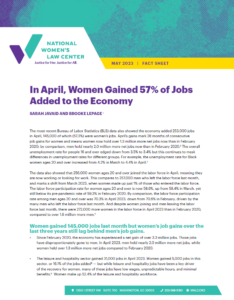Abortion rights, women of color, and LGBTQI+ people are under attack. Pledge to join us in fighting for gender justice.

 The most recent Bureau of Labor Statistics (BLS) data also showed the economy added 253,000 jobs in April, 145,000 of which (57.3%) were women’s jobs. April’s gains mark 28 months of consecutive job gains for women and means women now hold over 1.3 million more net jobs now than in February 2020; by comparison, men hold nearly 2.0 million more net jobs now than in February 2020. The overall unemployment rate for people 16 and over edged down from 3.5% to 3.4% but this continues to mask differences in unemployment rates for different groups. For example, the unemployment rate for Black women ages 20 and over increased from 4.2% in March to 4.4% in April.
The most recent Bureau of Labor Statistics (BLS) data also showed the economy added 253,000 jobs in April, 145,000 of which (57.3%) were women’s jobs. April’s gains mark 28 months of consecutive job gains for women and means women now hold over 1.3 million more net jobs now than in February 2020; by comparison, men hold nearly 2.0 million more net jobs now than in February 2020. The overall unemployment rate for people 16 and over edged down from 3.5% to 3.4% but this continues to mask differences in unemployment rates for different groups. For example, the unemployment rate for Black women ages 20 and over increased from 4.2% in March to 4.4% in April.
The data also showed that 256,000 women ages 20 and over joined the labor force in April, meaning they are now working or looking for work. This compares to 257,000 men who left the labor force last month, and marks a shift from March 2023, when women made up just 1% of those who entered the labor force. The labor force participation rate for women ages 20 and over is now 58.6%, up from 58.4% in March, yet still below its pre-pandemic rate of 59.3% in February 2020. By comparison, the labor force participation rate among men ages 20 and over was 70.3% in April 2023, down from 70.6% in February, driven by the many men who left the labor force last month. And despite women joining and men leaving the labor force last month, there were 272,000 more women in the labor force in April 2023 than in February 2020, compared to over 1.6 million more men.
Note: NWLC’s monthly jobs day analyses are generally not updated after publication and are provided for archival purposes. Please visit our main jobs day page for the most up-to-date analyses.




